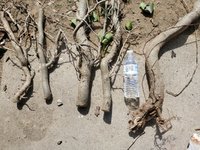Hi KateM,
Sorry for joining the conversation a bit late! I wanted to share my experience (so far) with propagating hardwood cuttings from my crabapple tree.
Back in early April, I attended a propagation presentation by Mark Moreland (there are a few posts about him around the forum). Inspired by that, on April 16 I took several cuttings from my tree—some fully hardwood, others semi-hardwood. The smallest was about ¾”, and the largest close to 2” in diameter.
I placed them in a transparent plastic box filled with moist, sterile coconut coir, after dipping each in rooting hormone. I misted everything with water and set the box on a north-facing windowsill here in England.
View attachment 600221
By May 2, all but two of the cuttings had pushed out several well-formed leaves, and I could see the beginnings of root development. At that point, I transferred them into individual pond pots filled with bonsai soil and placed them in a larger box outside, where they get morning sun.
View attachment 600222
I kept humidity high by misting frequently and opening the box for 1–2 hours each day for ventilation. Just this week, I removed the cuttings from the box completely, as I noticed some of the more cautious roots were reaching the edges of the pond pots.
View attachment 600223
From what I gathered during Mark’s presentation, hardwood cuttings have enough stored energy and nutrients to push out new leaves, but since they don’t yet have functioning roots to take up water, it’s crucial to maintain very high humidity (over 90%) during the early stages to prevent dehydration.
So far, this method seems to be working well—and I’ve just started trying the same process with black locust cuttings
View attachment 600224

 the ground and some stem cuttings with interesting branching..
the ground and some stem cuttings with interesting branching..
 the ground and some stem cuttings with interesting branching..
the ground and some stem cuttings with interesting branching..










